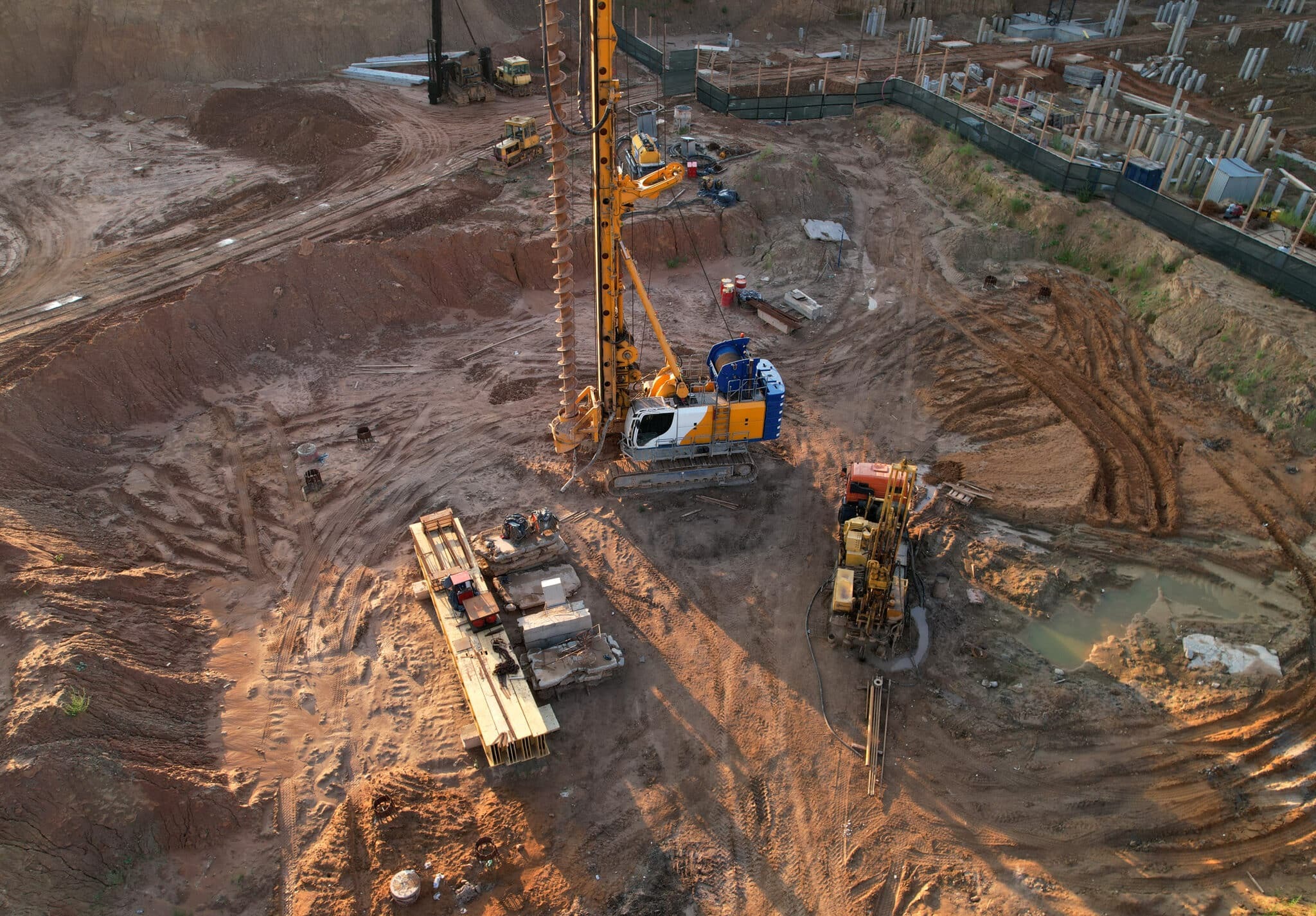In our recent article, we examined why the civil industry continues to face risks and project overruns due to unforeseen site conditions, and how digital solutions can mitigate these challenges.
In this article we will delve into ground investigation (GI), its role in infrastructure projects, and how civil engineers can maximise the value of their GIs by optimising them before and during fieldwork.
GI has long been a critical component of C&I projects. Yet its value is often misunderstood or underestimated.
Sharing their expertise on how to optimise GI with data are:
- Carl Grice, Geotechnical Information Management Director at Seequent
- Dr Georgette Hlepas Principle Geotechnical Engineer
- Warren Hoyle, Geotechnical Lead at Hatch
- Christopher Bennett, Geology Service Line Leader at GHD
Reframing the value of ground investigation
Traditionally, the civil industry has looked at GI through the lens of uncertainty and risk. This has led to a historical trend of underinvestment, with significant impacts on project outcomes — from increased costs and delays to poor decision-making.
By reframing the purpose and value of GI, we can shift the narrative from one of cost minimisation to one of value optimisation.
But this shift requires a psychological and strategic repositioning — one that emphasises the role of GI in enhancing certainty and understanding.
From uncertainty to certainty
The traditional focus on risk and uncertainty in GI often paints a picture of unknowns and potential problems.
Acknowledging and managing risk is essential, of course. But this perspective can inadvertently overshadow the value of GI: increasing certainty and confidence in decision-making.
For instance, a well-executed GI can significantly enhance the quality of design and planning. This not only reduces the likelihood of costly surprises later in the project lifecycle – it also enables better sustainability and resilience outcomes for the project.
By communicating GI’s value in a way that resonates with stakeholders — concentrating on the value of GI in terms of the clarity it brings to subsurface conditions — we can reposition it as a tool not just for reducing risks, but for maximising value.
This approach aligns with a growing trend in GI teams towards data-centric, risk-based methodologies — far more effective in showcasing the tangible benefits of targeted, data-driven GI. It elevates GI from a mere “cost line item” to a strategic asset that underpins the entire project.
Embracing technological advancements in GI
Technological advancements are key to achieving a data-centric approach in GI. The transition from domain-specific desktop tools to integrated, cloud-based environments provides a more holistic, collaborative method of understanding subsurface conditions.
The evolution from 2D to 3D modelling in cloud-based environments, for instance, has revolutionised the way GI data is visualised and interpreted. Developing a 3D model of a site enables earlier risk assessments and provides a deeper understanding of ground conditions.
“A better understanding of ground conditions allows a review of the risks at earlier stages of design, potentially unlocking opportunities to focus on sustainable material usage for a project.”
Warren HoyleGeotechnical Lead, Hatch
The value of GI goes one step further when centralising and standardising diverse data sources — like borehole data, geophysics, and aerial imagery. Integrating these datasets into 2D and 3D visualisations helps teams pinpoint areas of high and low certainty, allowing more targeted and efficient investigations.
Not only does this improve the quality of the GI, it also supports more confident and informed decision-making throughout the project.
“Using these datasets together and visualising them in 2D and 3D space can help to highlight areas where you may have more or less uncertainty and may need to target additional investigations.”
Dr Georgette HlepasPrinciple Geotechnical Engineer
Efficiency gains through scalable tools
Another critical component of a data-centric GI strategy is the adoption of scalable, adaptable tools that can grow with the complexity of a project.
The conventional mindset of using “simple tools for simple projects and complex tools for complex projects” often leads to inefficiencies and missed opportunities.
Instead, embracing advanced, scalable tools for projects of all sizes means teams can unlock significant efficiency gains.
These tools allow consistent data collection, analysis, and visualisation, so the benefits of data-centric GI are fully realised across a wide range of projects.
Optimising ground investigation before fieldwork
Using existing data
Before embarking on a new GI, maximising the use of existing data first is crucial.
Using historical data can significantly reduce the scope and cost of new investigations, helping project teams allocate resources more efficiently and focus on understanding the data, rather than searching for it.
“By implementing good data management practices to historic information, more time can be spent on understanding the available data rather than mining for it.”
Dr Georgette HlepasPrinciple Geotechnical Engineer
Utilising this past GI data not only saves time but also allows project teams to mitigate risks, refine designs, and make more informed decisions from the outset, streamlining the entire GI process.
“Historical investigations can therefore limit the amount of future investigations needed and increase cost savings to clients, communities, and the public.”
Christopher BennettGeology Service Line Leader, GHD
From desk study straight to design
In certain low-risk projects where confidence in existing data is high, it’s even possible to bypass traditional GIs altogether. This is particularly effective in projects that focus on the construction of simple infrastructure, where cost and schedule certainty are paramount.
By relying on robust historical data and desk studies, teams can move directly to design phases, saving both time and resources while still maintaining project integrity.
Scalable tools and technologies are vital for this approach, as they can easily adapt to the complexity of the project.
Scalability allows for a tailored approach to GI, allowing every project to benefit from the optimal level of investigation and data analysis.
From simple projects where historical data suffices to complex projects that demand new data collection, it’s crucial to have the right tools in place to assess and apply existing data effectively.

Assessing historical data quality
Using existing data offers numerous advantages. But it also comes with challenges — the largest being the quality and reliability of historical information.
Not all historic data is created equal — using outdated or inaccurate data can introduce risks rather than mitigate them.
So rigorously assessing the quality of available historical data is critical to optimising GI, before fieldwork begins.
Using automated quality assessment tools significantly enhances this process. By pre-screening data for suitability and reliability, it reduces manual effort and improves the overall efficiency of the GI process, using automated checks for data completeness, accuracy, and relevance.
By cutting time spent on manual data validation, project teams can instead allocate more resources towards strategic analysis and decision-making, ultimately improving project outcomes.
GI teams are increasingly using tools like Leapfrog in the planning process for geotechnical risk identification and mitigation. This helps them quickly spot deficiencies or areas of concern with historical data, to allow more targeted and effective GIs.
Optimising ground investigation during fieldwork
Timely access to data
In the field of GI, access to real-time data is a game changer — allowing iterative, responsive adjustments to enhance the efficiency and effectiveness of fieldwork.
Rather than following rigid, predefined plans, teams can use real-time insights to optimise their field activities — whether it’s fine-tuning drilling patterns or adjusting sampling regimes — based on the most current information available.
Not only does this improve the quality of collected data, it also ensures resources are used where they’re needed most, reducing waste and enhancing overall project value.
Real-time data plays a critical role in this process, enabling early identification and mitigation of risks — preventing costly adjustments later in the project lifecycle. Reducing the time spent on data collection and validation means project teams can focus more on analysis and decision-making, leading to more informed and confident actions during fieldwork.
“The better your understanding of the geotechnical risks, the better you are able to make decisions on how to address those risks. The earlier risks are identified in the project life cycle, the lower the cost will be to address them.”
Dr Georgette HlepasPrinciple Geotechnical Engineer
Data-centric collaboration across GI phases
One of the major challenges in GI is maintaining data continuity across different phases — especially when different parties conduct each phase. Inconsistent data formats, gaps in information, and a lack of collaborative tools can lead to redundant efforts, rework, and ultimately increased costs.
A data-centric approach to GI — emphasising continuous and collaborative data use throughout the project lifecycle — is essential to overcoming these challenges.
Collaboration isn’t just about sharing data — it’s about actively using that data to drive better decision-making.
By fostering collaboration between all stakeholders involved in the GI process — from initial planning through to fieldwork and beyond — teams can ensure that data isn’t just collected but actively utilised to inform each phase of the investigation.
This collaborative use of data helps avoid redundant field activities, including repeated sampling or unnecessary drilling, to ensure the entire project team is aligned on the subsurface conditions and associated risks.
“Opportunities come from reducing costs on unnecessary construction, which therefore can lead to more sustainable outcomes.”
Christopher BennettGeology Service Line Leader, GHD
Ultimately, using data more efficiently across the GI process:
- helps teams cut out redundant construction activities
- optimises material usage
- contributes to more sustainable project outcomes
The data-centric future of GI
As the landscape of GI continues to evolve, one thing is certain — technological advancements will continue to rapidly accelerate, driving up the volumes of available data. This will undoubtedly shape how we conduct GIs as an industry, with evolving methods of collaboration across teams and supply chains improving project outcomes.
But how future tools will use, analyse, and visualise GI data remains to be seen — especially when technologies like artificial intelligence (AI) and machine learning (ML) enter the fray and become more integrated into GI processes.
Data preparation is vital to prepare for this fast-approaching future of technological development. Organisations that invest in robust data cataloguing, centralisation, and standardisation now will be in a prime position to capitalise on future technological advancements.
Preparing data properly will allow teams to implement AI and ML more effectively. This bears the potential to transform the industry — not just by optimising current GIs, but paving the way for a more innovative, data-driven future.





